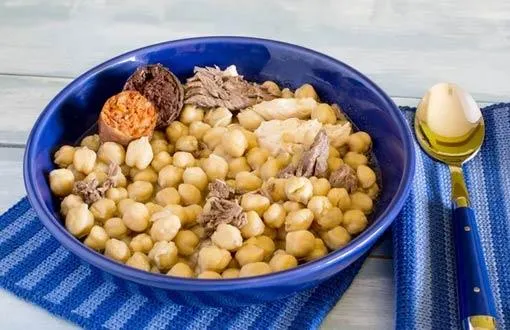Stew Croquettes
Ingredients
- Butter
- Milk
- Wheat flour
- Nutmeg
- Salt
- Black pepper
- Onion
- Olive oil
- Eggs
- Bread crumbs
- Leftovers from the stew (skinless chorizo and morcilla, chicken, hen, beef shank, ham...)

Preparation
- Heat the milk and flour in a saucepan over medium heat.
- In a separate pan, gently heat the butter with a little olive oil.
- Add the flour.
- Combine both mixtures and add salt, nutmeg and black pepper.
- Your béchamel is ready.
- Chop the stew leftovers and sauté them with onion, salt and pepper.
- Mix the meat with the béchamel. Let it cool.
- Shape the croquettes and coat them in beaten egg and bread crumbs.
- Chill them in the fridge for a while, then fry.
- All set!
The stew: the croquette that has it all
Stew is a straightforward yet soulful dish: a pot simmered with water.
Its main ingredients are:
- Chickpeas or white beans
- Beef, pork, chicken or mutton
- Sausages: streaky bacon, chorizo, morcilla
- Cabbage, turnip, potatoes, carrots...
- Ham bone
It’s a classic winter dish, full of everything, delivering a big dose of calories to tackle the harsh cold.
The usual way to eat it is in three servings:
- Soup or broth, plain or with noodles, tiny pasta shapes or rice
- Legumes and potatoes
- Meats and sausages
Everything goes into the pot at the right time, letting the art of slow cooking do the rest.
The list of stews is endless. Here’s a short overview to give you a sense of their variety.
- Peruvian sancochado: white beans, greens, pork...
- Valencian puchero: rice or pasta...
- Andalusian puchero: chicken, beef, a spreadable mix called pringá...
- Berza jerezana: from the Bay of Cádiz and Jerez; pork, cabbage...
- Rasol: from Romania, similar to Portuguese stew
- Madrid stew: broth with noodles, chicken...
- Lalín stew: all centred around pork...
- Lebaniego stew: from Cantabria; cabbage...
- Maragato stew: cherished in Astorga, León; cabbage...
- Medieval olla podrida: a historic Burgos dish, once eaten by the wealthy
- Catalan escudella: includes red, white and black butifarra sausages...
- Portuguese stew: with beef, pork...
- Galician stew: turnip greens, lacón, ribs and pig’s ear...
- Montañés stew: Cantabrian speciality with white beans...
- Andalusian stew: green beans, pumpkin...
- Stew with “pelotas”: in Almería (meat dumplings cooked with a sofrito of ñoras and peppers) and in Murcia (dumplings with pine nuts, bacon, minced pork and turkey liver)
Ropa vieja
This is the name given to leftover stew from lunchtime, cooked again in the evening with chopped onion and/or sweet or hot paprika.
The bones are removed before cooking.
Ropa vieja can also be prepared on its own using shredded, deboned meat. It can be used as a filling for arepas or similar dishes.
It’s a hearty, robust meal, very popular in Spain, especially the Canary Islands, and across South America, particularly in Cuba.
Stew croquettes are intense and full of flavour. Stew is rich in vitamins, proteins and minerals. It provides plenty of energy, though moderation is advisable to avoid overindulgence.
Esta entrada también está disponible en:
![]() Español
Español
